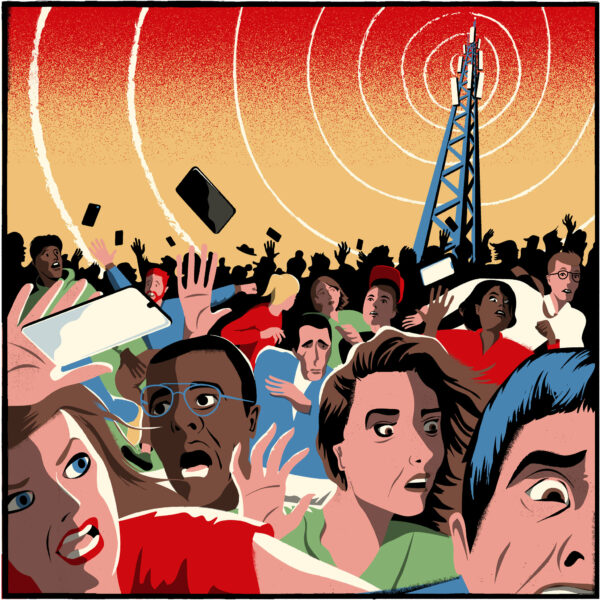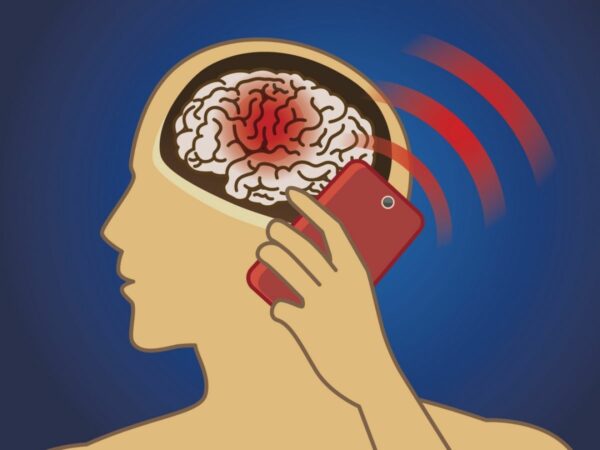Harmful Radiation from wireless devices that cause health issues in 2021

Radiation from wireless devices that cause health issues
The antennas in mobile phones, including smartphones, generate radiofrequency (RF) radiation (non-ionizing “radio waves” such as microwaves), which can be absorbed and converted to heat by the areas of the head or body closest to the antenna.
Scientists have been investigating whether the now-ubiquitous radiation linked with mobile phone antennas or cell phone towers has impacted human health since the 1990s.
Mobile phone networks employ a variety of RF frequency bands, some of which overlap with microwave frequencies. Similar radiation is produced by other digital wireless systems, such as data communication networks.
In 1996, the World Health Organization formed the International EMF Project to review the scientific evidence of possible health effects of EMF in the frequency range of 0 to 300 GHz in response to public concern.
They claim that, despite extensive research into the health effects of exposure to various parts of the frequency spectrum, all reviews to date have concluded that, as long as exposures are kept below the limits recommended in the ICNIRP (1998) EMF guidelines, which cover the entire frequency range from 0 to 300 GHz, such disclosures have no known adverse health effects.
Wireless radiation was classed as Group 2B – probably carcinogenic – by the World Health Organization’s International Agency for Research on Cancer (IARC) in 2011. That suggests there “maybe some danger” of carcinogenicity, implying that more research into long-term, intensive use of wireless devices is needed.
“Over the twenty years, a vast number of research have been conducted to examine whether mobile phones constitute a possible health risk,” according to the WHO.

Mobile phones
A mobile phone is connected to the telephone network by radio waves exchanged with a local antenna and automated transceiver known as a cellular base station. Each provider’s service area is divided into small geographical sections called cells, and each cell’s antenna communicates with all of the phones in that cell. Radio transmitters on both the phone and the tower communicate with one another.
Because the same radio channels are repeated every few cells in a cellular network, low-power transmitters are employed to prevent radio waves from one cell from spilling over and interfering with a nearby cell that uses the same frequencies.
Mobile phones have a maximum adequate isotropic radiated power (EIRP) of 3 watts. The network lowers the phone transmitter to the lowest power possible while maintaining high signal quality, often as low as one milliwatt when close to the cell tower. The EIRP power output of tower channel transmitters is typically approximately 50 watts.
A mobile phone generates radio signals on its control channel even while it is not in use unless it is turned off to maintain contact with its cell tower and for purposes such as passing off the phone to another building if the user crosses into another cell.
When a person makes a call, the phone sends a signal via a second channel that contains the user’s voice. Existing 2G, 3G, and 4G networks employ frequencies in the 600 MHz to 3.5 GHz UHF or low microwave bands.
Many wireless gadgets in the home, such as WiFi networks, garage door openers, and baby monitors, employ frequencies in this region.
As radio waves radiate out from a transmitting antenna, their intensity decreases fast by the inverse square of the distance. As a result, the phone transmitter, which is held near the user’s face when talking, exposes the user to far more radiation than the tower transmitter, usually hundreds of metres away.
Users can restrict their exposure by using headphones and holding the phone farther away from their bodies.
Higher frequencies in or around the millimetre wave range, 24 to 52 GHz, are used in next-generation 5G cellular networks, which began deployment in 2019. Because atmospheric gases absorb millimetre waves, 5G networks would require smaller cells, roughly the size of a city block, than earlier cellular networks.
Each cell will be served by an array of several tiny antennas put on existing buildings and utility poles rather than a cell tower. Millimetre waves penetrate biological tissue less deeply than microwaves and are absorbed primarily within the first cm of the body surface.
Cordless phones
According to the HPA, a DECT cordless phone’s radiation could exceed that of a mobile phone due to the mobile phone’s adaptive power capability. According to the HPA, while the DECT cordless phone’s radiation has an average output power of 10 mW, it comes in the form of 100 bursts per second of 250 mW, which is comparable to the strength of some mobile phones.
Wireless networking
The majority of wireless LAN equipment is built to work within predetermined parameters. Wireless access points are frequently close to people, yet the inverse-square law dictates that power drops rapidly as distance increases.
Wireless laptops, on the other hand, are typically used near people. WiFi has been linked to electromagnetic hypersensitivity anecdotally, but a study into the condition has found no systematic evidence to back up sufferers’ assertions.
Wireless networking device users are often exposed for substantially more extended periods than mobile phone users, and wireless device strength is not significantly lower. A wireless router can range from a standard 15 dBm (30 mW) strength to 27 dBm (500 mW) on the high end, but a Universal Mobile Telecommunications System (UMTS) phone can range from 21 dBm (125 mW) for Power Class 4 to 33 dBm (2W) for Power Class 1.
On the other hand, wireless routers are often placed far further away from users’ heads than a phone they are holding, resulting in substantially less overall exposure. According to the Health Protection Agency (HPA), spending a year in a location with a WiFi hot spot exposes a person to the same amount of radio waves as making a 20-minute phone conversation. “… radio frequency (RF) exposures from WiFi are expected to be lower than those from mobile phones,” according to the HPA.
According to the report, the report showed that there was also “no reason why schools and others should not employ WiFi equipment,” according to the report. On behalf of the UK government, the HPA initiated a new “systematic” investigation into the impacts of WiFi networks in October 2007 to ease anxieties that had surfaced in the media in the preceding months. According to HPA’s Michael Clark, published information on mobile phones and masts does not add to a case against WiFi.

Cancer
In contrast to ionizing radiation, there is no known mechanism by which radiofrequency radiation changes DNA and causes cancer. Mobile phone use was designated as “probably carcinogenic to humans” by the IARC, a World Health Organization working group, in 2011. “The human epidemiological evidence was mixed,” wrote the IARC in their findings.
Several tiny early case-control studies were thought to be mostly useless. Although extensive cohort research found no increased risk of relevant tumours, it lacked information on the extent of mobile phone use, and there were multiple potential sources of exposure misclassification.
The majority of the evidence came from the INTERPHONE research, a large international multicenter case-control study, and a second extensive case-control study on gliomas, meningiomas, and auditory neuromas from Sweden.
These studies found a link between glioma and acoustic neuroma and mobile phone use, particularly in people with the highest cumulative use of mobile phones, in People who had used mobile phones on the same side of the head as the side on which their tumour originated, as well as those whose tumour was in the temporal lobe of the brain, were more likely to get cancer (the area of the brain that is most exposed to RF radiation when a phone is used). According to the CDC, there is no conclusive scientific evidence that cell phone use causes cancer.
Fertility and reproduction
There has been a decline in the quality of male sperm during the previous few decades. The effects of the radiofrequency electromagnetic radiation (RF-EMR) released by these devices on the reproductive systems are currently under active debate, and studies on the influence of mobile radiation on male fertility are conflicting.
“Together, the results of these investigations have revealed that RF-EMR reduces sperm count and motility while increasing oxidative stress,” according to a 2012 review. Self-reported mobile phone use was not connected to semen quality, according to a 2017 study of 153 men who attended an academic reproductive clinic in Boston, Massachusetts. According to the study, carrying a mobile phone in the pants pocket was also not related to semen quality.
5 G radio frequencies influence male fertility in the 450 MHz to 6,000 MHz range, may affect female fertility and may have negative consequences on the development of embryos, foetuses, and neonates, according to a 2021 evaluation. Due to a lack of relevant investigations, no conclusions could be formed for higher frequencies.

Electromagnetic hypersensitivity
Some mobile phone and related gadget users have reported experiencing a variety of non-specific symptoms both during and after use. Any of these symptoms have not been linked to electromagnetic exposure in studies. Furthermore, EHS is not a recognized medical condition.
Glucose metabolism
According to the National Cancer Institute, two short studies investigating if and how mobile phone radiation impacts brain glucose metabolism yielded mixed results.
Effects on children
The Australian Government’s Radiation Protection and Nuclear Safety Agency (ARPANSA) published a study in June 2017 that stated:
In 2010, the WHO Research Agenda recognized a lack of sufficient evidence relating to children, which is still the situation. Since no long-term prospective study has been conducted on this topic yet, more research is urgently needed. In the case of cancer, just one complete case-control study encompassing four European nations looked into the use of mobile phones by children and adolescents and the chance of developing a brain tumour and found no link (Aydin et al. 2011). Given the scarcity of data on children’s use of cell phones and cancer, further epidemiological research are required.
Base stations
According to experts consulted by France, the central antenna axis should not be immediately in front of a living place at a distance of fewer than 100 metres.
This proposal was changed in 2003 to specify that antennas within a 100-meter radius of primary schools or childcare facilities should be better incorporated into the cityscape. However, it was left out of a 2005 expert study. According to the Agence française de sécurité sanitaire environnementale, there is no evidence of a short-term effect of electromagnetic fields on health.
Still, there are unresolved questions about long-term consequences, and technological advancements can quickly reduce exposure. According to a study published in Environmental Research in 2020, “although direct causation of negative human health effects from RFR from cellular phone base stations has not been finalized,” “there is already enough medical and scientific evidence to warrant long-term liability concerns for companies deploying cellular phone towers,” and recommended voluntary setbacks from schools and hospitals.
Safety standards and licensing
Governments and regulatory authorities develop safety standards, which translate to limitations on exposure levels below a specific amount, to safeguard the population living near base stations and users of mobile devices. There are other proposed national and international standards.
Still, the International Commission on Non-Ionizing Radiation Protection (ICNIRP) standard is the most widely accepted, having been adopted by over 80 countries so far. The ICNIRP recommends two safety thresholds for radio stations: one for occupational exposure and another for the general public. Efforts are currently being made to standardize the various standards in use.
In most urban areas, radio base licencing procedures have been established and are regulated at the municipal/county, provincial/state, or national level. In many places, mobile phone service providers are obliged to get building permits, offer certification of antenna emission levels, and ensure compliance with ICNIRP regulations and other environmental laws.
Many regulatory agencies also force competing telecommunications firms to share towers to reduce environmental and cosmetic damage. This is a significant factor in community opposition to installing new antennas and towers.
Lawsuits
Individuals in the United States have filed personal injury lawsuits against manufacturers (including Motorola, NEC, Siemens, and Nokia) alleging brain cancer and death due to their products. In federal courts in the United States, expert testimony relating to science must first be assessed by a judge in a Daubert hearing to determine whether it is relevant and valid before being admitted as evidence. In a 2002 complaint against Motorola, plaintiffs claimed that using wireless portable telephones could induce brain cancer and that using Motorola phones caused one plaintiff’s disease.
The judge decided that the plaintiffs had presented no sufficiently trustworthy and relevant scientific evidence favouring either general or specific causation, accepted a request to exclude the plaintiffs’ experts’ testimony, and dismissed a motion to exclude the defendants’ experts’ testimony. In two separate trials in Italy, in 2009 and 2017, plaintiffs who claimed their benign brain tumours were caused by extended mobile phone use in professional work for 5–6 hours per day, which they concluded was different from non-professional use, were given pensions.
Legal Action Against 5G in the United Kingdom sought a Judicial Review of the government’s 5G deployment plan. If they were successful, the party was to be represented by Michael Mansfield QC, a well-known British barrister. The government had proven that 5G was as safe as 4G, and the applicants had launched their action too late. Hence this application was dismissed.
Precautions: Precautionary principle
The World Health Organization (WHO) recommended in 2000 that the precautionary principle be applied voluntarily in this situation. It adheres to the European Community’s environmental risk recommendations.
“A risk management policy adopted in conditions with a high degree of scientific ambiguity, reflecting the necessity to take action for a potentially serious danger without waiting for the results of scientific research,” according to the WHO. Two less strict strategies offered are the prudent avoidance principle and as low as reasonably practicable. Even though all of these are difficult in practice, due to the extensive use and economic importance of wireless telecommunication systems in modern civilization, such measures are gaining appeal among the general public, despite evidence that such tactics may cause concern.
They include recommendations such as limiting use by at-risk populations (e.g., children), adopting phones and microcells with as low as reasonably practicable levels of radiation, expanding the use of hands-free and earphone technologies like Bluetooth headsets, adopting maximal exposure standards, RF field intensity and distance of base station antennas from human habitations, and so on. Overall, public information continues to be an issue since numerous health repercussions are invoked in the literature and media, regularly exposing communities to potentially alarming news.
Preventive measures and health advisories
The International Agency for Research on Cancer of the World Health Organization classified electromagnetic fields from mobile phones and other sources as “possibly carcinogenic to humans” in May 2011 and advised the public to take precautions to reduce exposure, such as using hands-free devices or texting.
Some national radiation advisory bodies, such as those in Austria, France, Germany, and Sweden, have urged that residents be exposed to as little radiation as possible. The following are some examples of recommendations:
- To reduce radiation to the head, use hands-free mode.
- Keep your phone away from your body.
- If you don’t have an external antenna, don’t use the phone in your automobile.
The British Consumers’ Association said in a statement in November 2000 that using “hands-free” was not recommended because it increased exposure. Measurements for the (then) UK Department of Trade and Industry and others for the French Agence française de sécurité sanitaire environnementale, on the other hand, revealed significant reductions. Professor Lawrie Challis and colleagues claimed in 2005 that connecting a ferrite bead to hands-free equipment prevents radio waves from travelling up the wire and into the skull.
Children should use mobile phones in moderation, according to several countries. According to a 2006 study by Gandhi et al., children had higher Specific Absorption Rate (SAR) levels. When comparing 5- and 10-year-olds to adults, they receive roughly 153 per cent more SAR. Furthermore, because the permittivity of the brain decreases with age and children’s exposed growing brain has a larger relative volume, radiation penetrates far beyond the midbrain.
edited and proofread by nikita sharma





